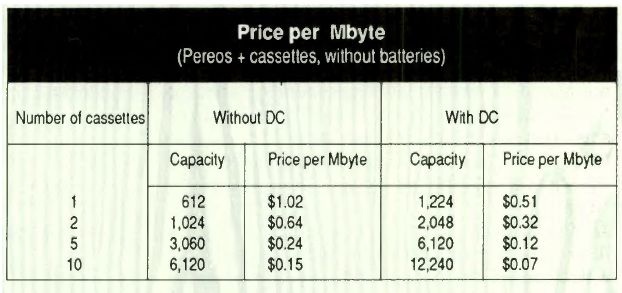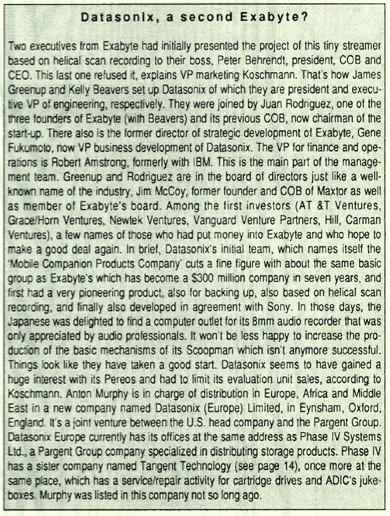History (1994): World’s Smallest Tape Drive Size of Stamp From Datasonix
Pereos, 612MB, based on Sony cartridge size of stamp
By Jean Jacques Maleval | January 19, 2021 at 2:28 pmPereos is a new tiny tape drive based on a Sony cartridge, the size of a stamp with a native capacity of 612MB.

Will the originator of the helical scan recording unit, the Colorado-based Datasonix start-up, become a new Exabyte?
Since the advent of 4mm DAT, it’s the most innovative and exciting product in the tape backup industry. Named Pereos (pronounced ‘PEAR-os’, derived from the Greek ‘peraion’ meaning ‘to transport’), it is a 2.5mm DAT, the first real mobile tape drive.
Until now, nothing was under the 3.5-inch form factor. Pereos, the product launched by Datasonix (Boulder, CO) is only 2.4 inches (6cm) wide, by 4 inches (10cm) high and 2 inches (5cm) long for 10 oz.
The device is actually 2 pieces – a base containing batteries and the computer chips that control the recorder, and a detachable unit that holds the cartridge and contains the recording mechanism. It allows the user to leave a base plugged into each computer and shuttle the detachable recording component between them.
At the origin, Sony’s Scoopman Pereos uses the Digital Micro Recorder NT-1 (or Scoopman) mechanism from Sony, a product launched in 1992. It’s a digital audio recorder that didn’t have very much success because the unit (about $600) and the cassettes were too expensive, and additionally, it couldn’t be used to record music. But it’s a perfect tool to record conversations.
We have been using it for a long time to tape our interviews. However, our main complaint is the poor reliability of the microphone and earphone connectors, like on most walkmans. In this audio version, you can record, depending on the cassette, 60, 90 or 120 minutes of a conversation with an amazing quality.
It’s the only cassette with the longest tape or NT-120, but slightly changed, that is accepted on the Pereos.
It uses just an R6 (size AA) battery (compared to 2 in the Pereos), which allows a continuous 7-hour recording or 6-hour playing.
Cassette the size of a stamp
At the heart of the system is a micro-mechanism incredibly miniaturized. The most amazing part is the size of the cassette, tiny, just like a regular stamp, 1.18 inches (3cm) long, 1.85 inches (2.2cm) wide and 0.2 inches (0.5cm) thick. Inside is a tape 0.1 inch (2.5mm) wide and 73.1 inches (24.8cm) long.
Some changes would have been done on Sony’s NT-120 cartridge for a better reliability. This way Datasonix will be able to grant itself a margin, not only on the sales of the drive, but also of the cassettes bearing its logo.
The tape moves at 1.25 inches (6.35mm) per second. It is pressed by a drum spinning at 3,000rpm with 4 heads (compared to 3 on the Scoopman) and 9.8MU!!! wide tracks that are written at an angle of about 4.4°.
A keypoint of Sony’s Non-Tracking (NT) format is that the drum enters the cassette, is just pressed vs. the tape guides, and the tape wraps around automatically.
With conventional helical scan (DAT, 8mm or VHS), it is necessary to have a loading mechanism that drew out the tape from the cassette and wrapped it around the fixed external rotary drum. Additionally, the heads on the drum are not required to precisely trace the recorded tracks during playback.
The data picked up may be disconnected or fragmented; however, the IC memory rearranges and augments the data to faithfully recognize them.
Datasonix didn’t change the mechanism, it just increased the tape path in search mode to reach an average 60s access time.
Modifications were also made on the proprietary recording format and the ECC. A major point for Datasonix is the change in the form factor which even was the subject of a patent registration by the Colorado firm.
Of course, all the electronic parts concerning the audio recording were changed and Datasonix has conceived a proprietary controller with its own ASIC.
At the end, the total volume of the Pereos is 2x bigger than the volume of the Scoopman, which only represents the size of 2 packs of cigarettes, ‘less space than a soft drink can’, said the company.

612MB of uncompressed data
In a drive with such a small format, the tiny removable cassette allows the recording of 612MB, or close to double with Stac Electronics’ data compression software.
Actually, the online availability is only half that much since you have to turn the cassette over by hand to use the other side of the tape.
But the device is very slow. In native mode, backup rate is 5 MB/mn (2x faster with DC) or 83KB/s. For instance, it takes about 2 hours to backup a 600MB compact disk.
Anyway, you couldn’t expect much more when the only possibility offered is a connection to the parallel printer port, even if this one was improved by the company which has patented a new technique to enhance the movement of data on older systems that have only uni-directionnal protocol. The transfer rate is doubled by bursting the data in byte or nibble mode.
An optional connector is available to allow the use of a printer at the same time.
A PCMCIA interface ought to be available in 1994, and later a SCSI interface is planned.
Datasonix estimates the average length of the 2 AA batteries life to 4 months ‘depending upon frequency of use’.
According to Steve Koschmann, VP marketing (who comes from Peter Norton), this length of time is calculated for an average backup of 10 to 50MB per week.
In the documentation from Datasonix, there is no mention of an eventual cleaning cassette for the Pereos, but it will probably come out, just like for the Scoopman. All tape recorders, especially those with helical scan recording require a regular cleaning of the heads.
An important point here: the cassettes don’t have to be formatted like most removable computer-related supports, this means an interesting gain of time for the user. On account of a checking after write system, which means an immediate reading of what has just been written to check its content, no write verification pass is required.
The PereoSoft software, developed by Datasonix and offered with the device, seems to be very well done providing backup, restoration, offload, onload, export/import between notebook and desktop, file revision management, DR facilities, utilities and more. This software works under DOS 5.0 or later, Windows 3.1, Intel compatible 386 or above, and at least 8MB available disk space.
No internal version now
For the time being, no stacker or library for several cassettes is available, “but some companies came to see us and we are looking at several possibilities,” said Koschmann.
First, Datasonix will only sell directly an external version of the Pereos via an 800 telephone line or through distributors or third party vendors like for example Dell or Toshiba which could put it in their add-on product catalog.
But we can expect an internal version to be offered on the market afterwards. It would indeed be of great interest for notebook manufacturers to be able to integrate a Pereos directly into their microcomputers, in addition to a HDD, a diskette drive and PCMCIA slots.
With its small size, the Pereos is the only streamer able to find a place in a notebook today. And it could just simply replace the diskette drive with a similar volume but a capacity 400x greater.
The initial end user price of the drive ($595) just like the cassettes ($29.95 each) will probably be lowered if necessary.

By starting at a high price, Datasonix hopes to soak up its initial research expenses and finance its following needs.
Agreement with Sony
Koschmann explains that the agreement between Sony and Datasonix is “exclusive for a period of time.”
Except if the Japanese wanted it, Datasonix would be the only one able to develop a streamer based on the Scoopman.
“Sony will have to do it,” he says.
The entire drive assembly and cassette manufacturing will be done by Sony in Japan. Then the drives will be sent to Datasonix, in Boulder, CO, for testing, packaging and shipping throughout the world.

This article is an abstract of news published on the former paper version of Computer Data Storage Newsletter on issue 79, published on August 1994.













 Subscribe to our free daily newsletter
Subscribe to our free daily newsletter
